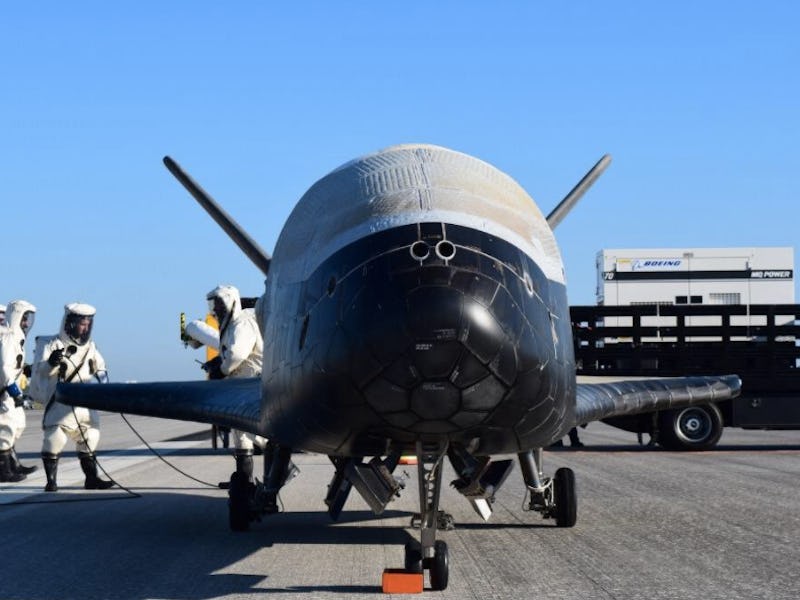The Crusty X-37B Space Plane Is as Mysterious as It Is Dirty
It returned to Earth after 718 days.

When an unmanned space plane landed unceremoniously Sunday morning at NASA’s Kennedy Space Center, the only warning of its arrival was a sonic boom heard across central Florida. Shortly after landing, the U.S. Air Force got on Twitter to announce that the very loud spacecraft was an X-37B, a Boeing-made Orbital Test Vehicle that had been orbiting the Earth’s atmosphere for the past 718 days.
The X-37B is part of a classified space program that began at NASA in 1999 and was transferred to DARPA in 2004. The Air Force has successfully flown four separate UTV missions, spacecraft in 2010 and clocking a total of 2,085 days in orbit — but the mission’s trajectory and details about the project’s purpose are shrouded in secrecy.
Here’s how the X-37B looks preflight, white as snow:
Beautiful.
When it returned to Earth, it was showing the wear and tear of a plane that’s been in flight for two years:
The X-37B Orbital Test Vehicle landing in 2012.
The Air Force has essentially been feeding the public the same line on the X-37B missions since it took over the project. The purpose of the X-37B is to demonstrate reusable spacecraft technologies and to operate experiments which can be returned to Earth for examination.
“We are incredibly pleased with the performance of the space vehicle and are excited about the data gathered to support the scientific and space communities,” Lt. Col. Ron Fehlen, X-37B program manager, said in a statement on Sunday.
Naturally, what the X-37Bs are actually doing up there has been on the minds of space enthusiasts for the better part of the last decade.
Evidence of Low Orbits
Back in 2015 Space.com reported on a network of amateur astronomers who had managed to track portions of the X-37B’s latest orbit shortly after its May 20 launch.
“It’s in a lower orbit than normal … had us confused for a while, as I thought it would be the standard operating orbit,” Greg Roberts, of Cape Town, South Africa, told Space.com.
Another member of the network, Ted Molczan of Toronto, had some theories:
“One thing that OTV-4 has in common with each of its predecessors is that its ground track nearly repeats after every 31 revolutions, which takes two days. This could be in support of a surveillance mission, to permit targets to be revisited frequently, or it may serve some other more mundane operational purpose that we have not discovered.”
A two-second–long exposure through power and telephone lines shows a white line indicating the X-37B space plane in orbit.
A Spy Mission?
The spacecraft comes with a seven-foot-long by four-foot-wide payload bay, and what it’s being used for is — you guessed it — unknown.
Due to the vehicle’s low orbit, it’s been speculated that the X-37B OTVs are conducting spy missions for the Air Force.
In 2012, the BBC published a report that stated that the second mission’s similar orbit to Tiangong could imply that it was spying on the Chinese space lab.
Brian Weeden, a technical adviser with the Secure World Foundation and a former orbital analyst with the U.S. Air Force to Space was quick to disagree. He told Space.com that although the vehicles’ orbits appear similar, they only intersect twice per circuit, and at speeds so high it would be difficult to gather any data.
According to Space.com, rather than racing around the Earth in a polar orbit, the second X-37B mission was repeatedly flying over a stretch of the globe from 43 degrees north latitude to 43 degrees south. “It’s probably using that new technology to observe the Middle East and Afghanistan,” Weeden said.
Reconnaissance Payloads
With the orbital path of the most recent X-37B being classified, James Andrew Lewis, director and senior fellow in the Strategic Technologies Program at the Center for Strategic and International Studies, gave Air&Space an indication of what kind of work it might be doing, even if we can’t verify where it’s doing it.
“I think that’s probably what they’re not telling you, that there are payloads in there that might be part of the design for future reconnaissance satellites,” he said, noting that the Air Force is looking to transition away from large, expensive satellites to smaller, more advanced versions.
A fifth X-37B mission is expected to be launched from Cape Canaveral Air Force Station in Florida later this year.